Government intervention in Microeconomics
1/68
There's no tags or description
Looks like no tags are added yet.
Name | Mastery | Learn | Test | Matching | Spaced |
|---|
No study sessions yet.
69 Terms
forms of government intervention
price controls : price ceilings + floor
indirect taxes
subsidies
direct provision
command and control regulation + legislation
consumer nudges
why do governments intervene in markets
earn revenue for the government
provide support to firms
provide support to households on low income
influence the level of production of firms
influence the levels of consumption of households/consumers
correct market failure
promote equality
why do governments provide support to firms?
support to smaller firms to help them get established + be able to compete.
support to firms in an industry whose growth the governments want to encourage. (e.g produce environmentally friendly forms of energy.)
in the form of subsidies or floors
protect domestic firms from foreign competition (support through trade protection measures)
how does the government provide support to low income households
subsidies, price ceilings, direct provision of services (e.g healthcare, education)
transfer payments : e.g unemployment benefits, child benefits, maternity benefits,etc.
command and control definition
government laws and regulations that everyone must follow
indirect taxes definition
taxes levied on spending to buy goods and services
paid partly by consumers but are paid to the government by producers
direct taxes definition
taxes paid directly to the government tax authorities
e.g income taxes, corporate income taxes, wealth taxes
do taxes increase or decrease allocative efficiency?
depends on the degree of allocative efficiency before tax is imposed
economy begins with efficient allocation of resources → tax creates inefficiency and welfare loss
Why do governments impose indirect taxes
source of government revenue
discourage the consumption of demerit g/s
can be used to redistribute income (tax goods that only high income earners can buy)
improve the allocation of resources by correcting negative externalities
types of indirect taxes
ad valorem taxes
specific taxes
ad valorem vs specific taxes
ad valorem - percentage tax, amount of tax increases as price increases
specific - fixed amount per unit on top of sales price
affect of indirect taxes on demand and supply graph
decrease in supply (shift left/upwards) by amount of tax (S2=S1+tax) (vertical difference between S curves = tax per unit)
government revenue = Q tx (Pc-Pp)
Pp= price recieved by producers after tax

market outcomes due to indirect taxes
equilibrium quantity falls from Q1 to Qt
equilibrium price rises from P1 to Pc (price paid by consumers
firms revenue falls from P1xQ1 to
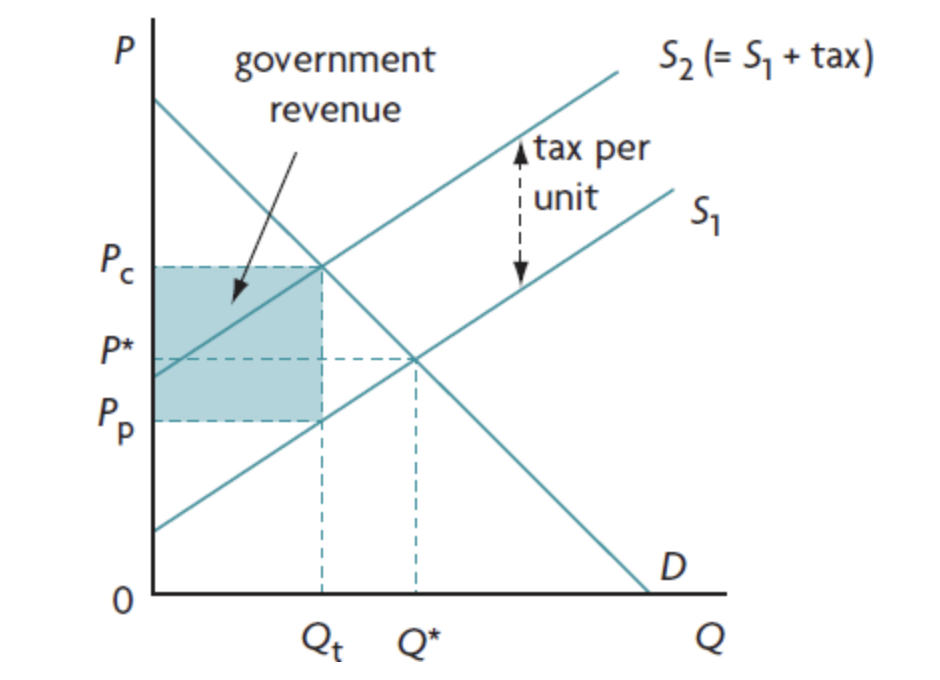
consequences of indirect taxes on consumers + producers.
consumers - increase in the price of the g/s + decrease in the quantity they buy.
producers - fall in price they recieve + fall in quantity they sell → fall in revenue
consequences of indirect taxes on the government + workers
government - only stakeholder that gains → increase in revenue
workers → lower amount of output means that fewer workers are needed → taxes lead to unemployment
how do indirect taxes affect society as a whole
society is worse off as a result of the tax due to underallocation of resources to the production of the good (Qt<Q1) (underproduction)
taxes create deadweight welfare loss
government tax revenue goes back into society through government spending
after tax MB>MC and so consumers would be better off if more of the good would be produced
affect of indirect taxes on consumer and producer surplus
portion of CS goes to government tax revenue portion of PS goes to government tax revenue
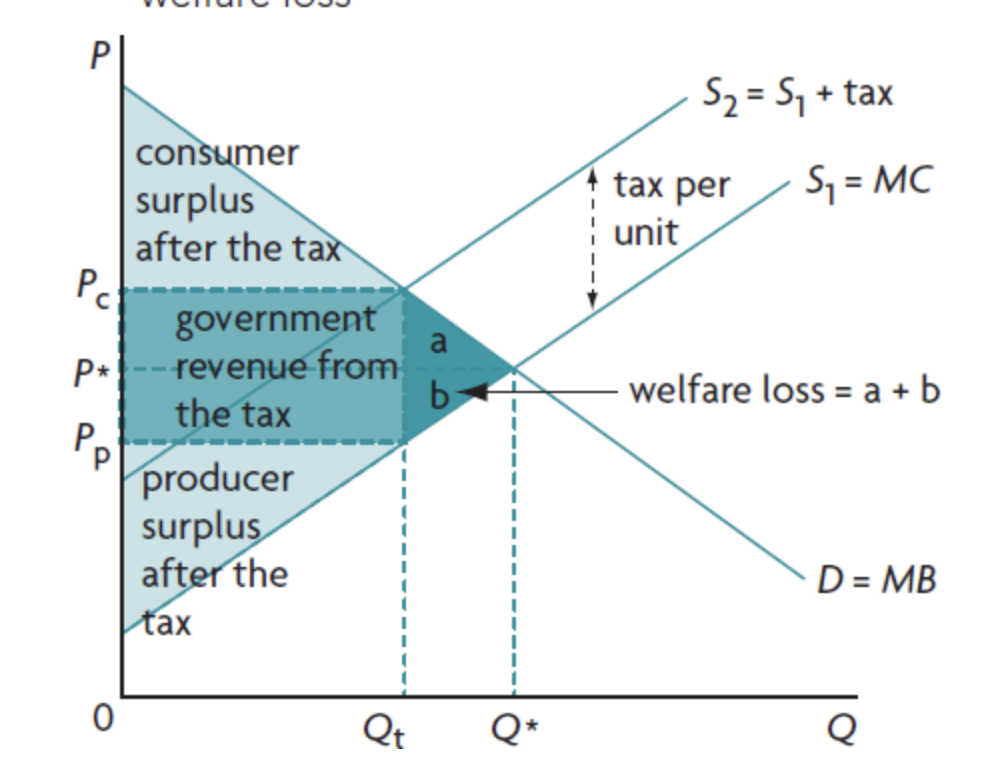
affect of indirect taxes on social surplus
after tax social surplus = after tax consumer surplus + after tax producer surplus + government tax revenue
after tax social surplus is less than before tax social surplus by the DWL
why do indirect taxes create deadweight welfare loss?
taxes cause a smaller than optimum quantity to be produced → allocative inefficiency
how to calculate price received by producers after an indirect tax
price that consumers pay - tax per unit
how to calculate government revenue after tax
(price paid by consumers - price received by producers) x tax per unit
subsidy definition
amount of money paid by the government to producers in order to lower the costs of production per unit.
types of subsidies
direct cash payment (type: specific subsidy → fixed amount per output)
low interest/interest free loans
direct provision of g+s by the government below equilibrium price
tax relief
others
why do governments grant subsidies
increase revenue of producers
make necessity goods affordable for low income workers
encourage the production + consumption of merit g/s
support the growth of particular industries in an economy
encourage exports of a particular good
improve allocation of resources by correcting positive externalities
what is the new consumer expenditure + producer revenue after a subsidy
consumer expenditure - price paid by consumer x quantity
producer revenue - (price paid by consumers x quantity) + subsidy per unit

market outcomes due to subsidy
equilibrium quantity produced + consumed increases (from Q1 to Qsb)
equilibrium price falls
price recieved by producers increases
overallocation of resources as Qsb is greater than Q1
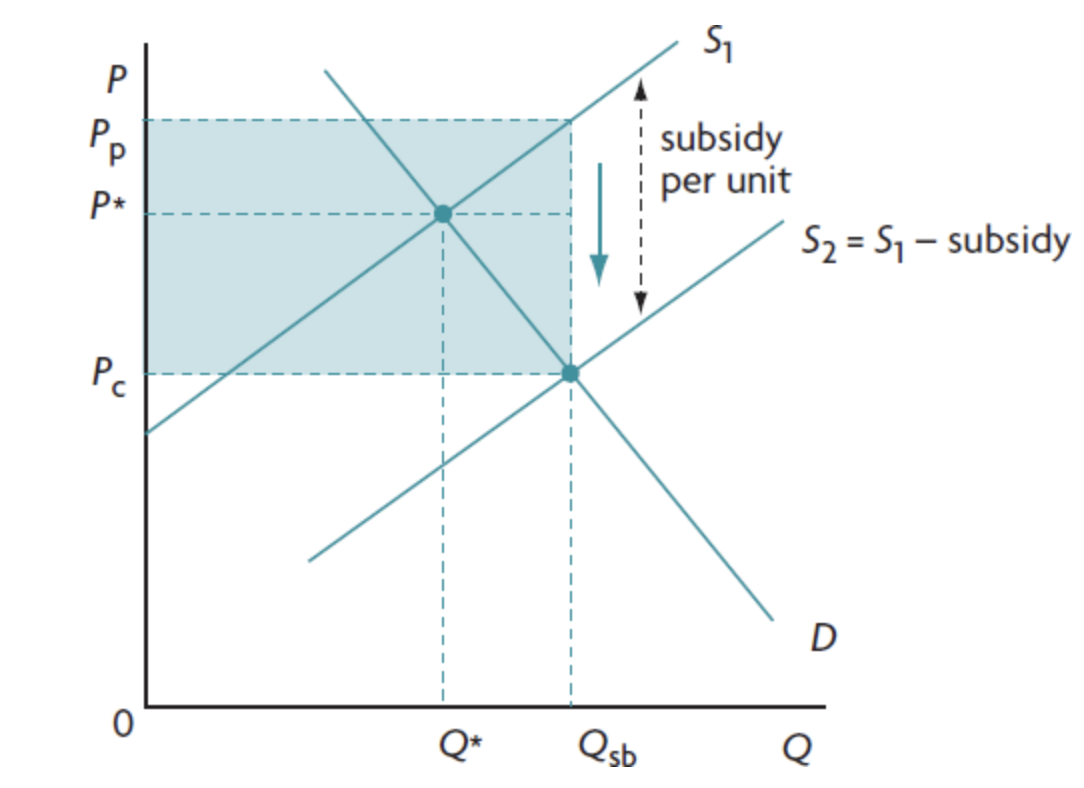
government spending on subsidy calculation
amount of subsidy = ( price received by producers - price paid by consumers) x Qsb
consequences of subsidies on producers + consumers
consumers - better off as they can buy more of the good and at a lower price
producers - better off as they receive a higher price and produce a larger quantity (increase in revenue)
consequence of subsidy on the government + workers
government - pays subsidy → burden on budget → has to reduce expenditure somewhere else/raise taxes/run in a budget deficit
workers - subsidies increase supply → firms are likely to hire more workers (workers who find a job are better off)
consequence of subsidy on society as a whole
worse off due to overallocation of resources to the production of the good (overproduction) (Qsb>Q1)
higher price received by producers protects inefficient ones and allows them to continue producing
consequence of subsidy on consumer + producer surplus
both CS and PS increase
social loss due to government subsidy are greater than the gains in CS + PS by the amount a=DWL → caused by larger than optimum qt. produced
society would be better of if less of the good was produced since MB<MC

how do subsidies on exports affect foreign producers
good for domestic producers as they are more internationally competitive
bad for foreign producers as they might not be able to compete with the lower price of subsidised goods
price controls definition
setting of minimum or maximum prices by the government (or private organisations) and do not allow a new equilibrium creating shortages or surpluses
price floor definition
a legally set minimum price
price floor on demand + supply diagram
excess supply is created (amount = difference between Qs and Qd)
increase in quantity supplied (expansion)
decrease in quantity demanded (contraction)
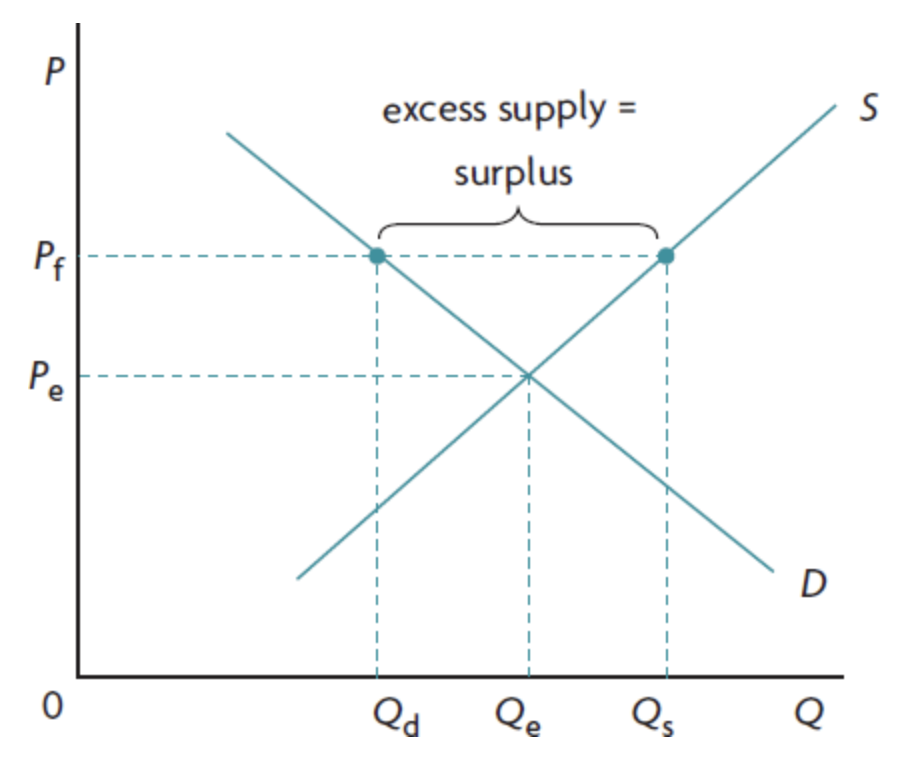
why do governments impose price floors?
provide income support to farmers (price control in product market)
to protect low-skilled low-wage workers by offering them a wage higher than the equilibrium (price control in resource market)
farmers incomes before setting a price floor
before price floor farmers incomes are unsustainable/too low due to unstable agriculture product prices which occurs due to low PED + PES
Low farmer incomes may arise due to low YED
buffer stock scheme
governments buy up the excess supply → demand curve shifts to the right
allows government to maintain price floor (without it farmers would have excess supply and no buyers)
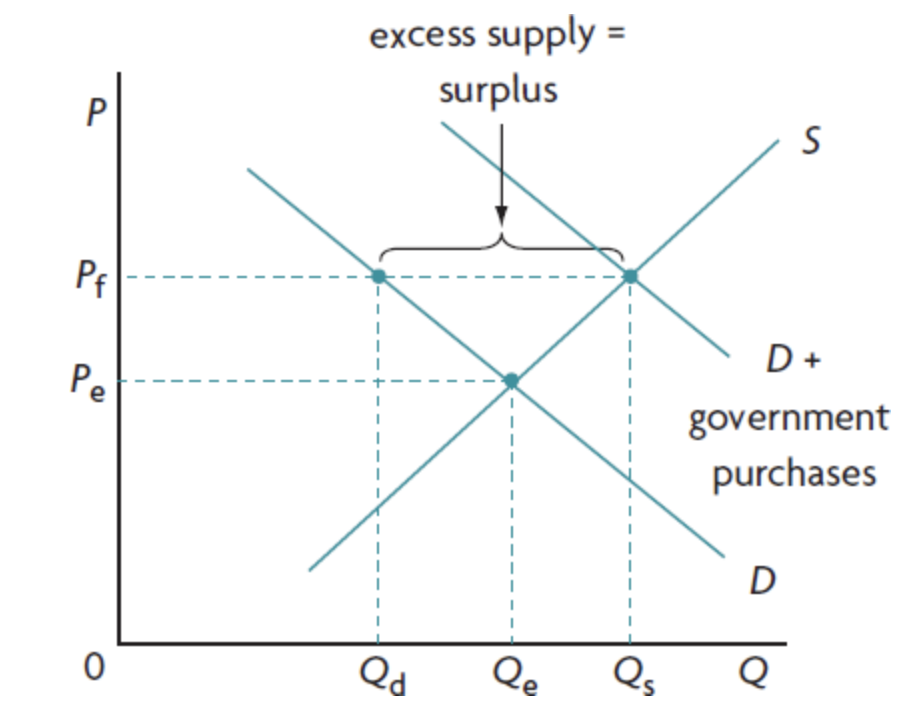
What does the government do with the excess surplus it buys from buffer stock scheme
store it - however gives rise to additional storage costs above purchasing costs
export surplus - requires subsidy to lower price of good as foreign consumers wouldn’t want to buy it at the higher price
consequence of price floor on firm efficiency
leads to inefficiency
this is as they are not incentivised to lower the costs by using a more efficient production method as the high price offers them protection
allocation of resources after a price floor is set
overallocation of resources to the production of the good (overproduction) → allocative inefficiency
more than optimum quantity produced
MB<MC indicates that society is getting too much of the good

label
new CS = a
new PS = b+c+d+e+f
sum of CS and PS increases by f
area b+c is lost by consumers and gained by producers
DWL = c+e+g+h
excess supply = i

how to calculate government spending to buy excess supply after a price floor
price paid per unit x surplus quantity it purchases (Qs-Qd) (rectangle outline)
consequences of price floors for consumers + producers
consumers - worse off → pay a higher price + buy a smaller quantity (loss in CS)
producers - gain → receive a higher price + produce a larger quantity → increase revenue due to government buying surplus
consequences of price floors for workers + government
workers - better off as employment increases due to greater production needed
government - worse off due to having to buy excess supply → burden on budget → cannot use the money on other desirable activities. Also further costs arise for storing/exporting excess supply
consequences of price floors for stakeholders in other countries
more developed countries rely on price floors to support farmers. → excess supply then exported at lower price → lower world prices due to extra supply available
countries without price floors are forced to sell agricultural products at low world prices → signals local farmers to cut back on production → under allocation of resources
overall a global misallocation of resources occurs (waste in resources) as price floors cause high-cost producers to produce more and low-cost producers to produce less than social optimum
minimum wage definition
a minimum price of labour set by governments in order to ensure that low-skilled workers can earn a wage high enough so that they can afford necessity goods/services. (type of price floor)
affect of minimum wage on demand + supply diagram
higher quantity of labour supplied
lower quantity of labour demanded
excess supply of labour (=Qs-Qd)→ unemployment
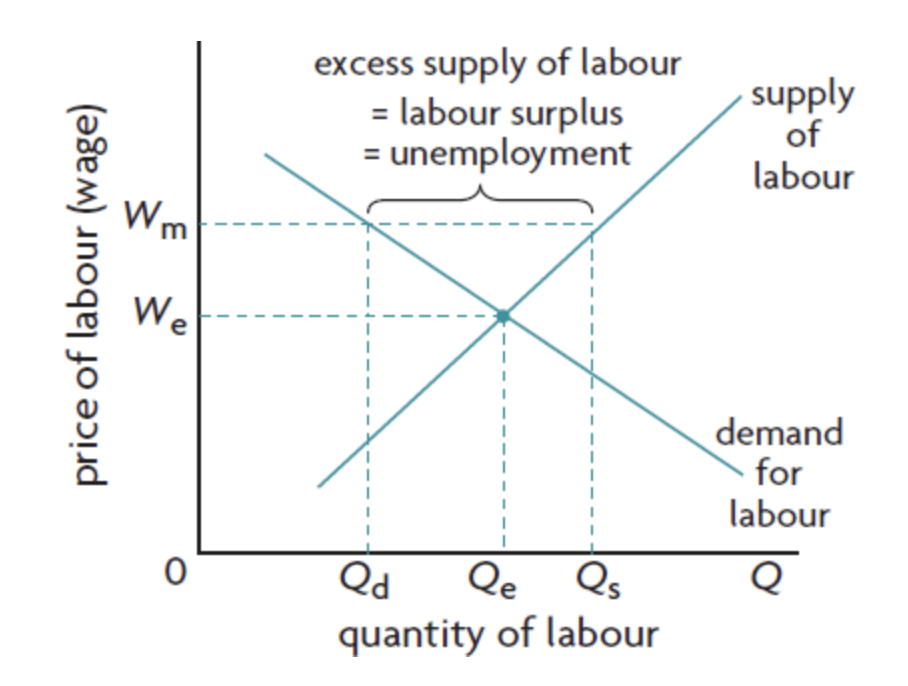
consequences of minimum wages on illegal workers
minimum wages result in the employment of workers that get illegally paid under the minimum wage (usually involves illegal immigrants)
consequences of minimum wages on allocation of labour resources
leads to misallocation of labour resources
industries that rely on un-skilled workers are more likely to be affected + hire less unskilled workers
consequences of minimum wages on allocation in product markets
costs of production increase for firms that rely on unskilled workers → decrease in supply/leftward shift
misallocation of labour resources → misallocation in product markets
consequences of minimum wages on consumers
worse off
increase in labour costs → decrease in supply → higher product prices + lower quantities
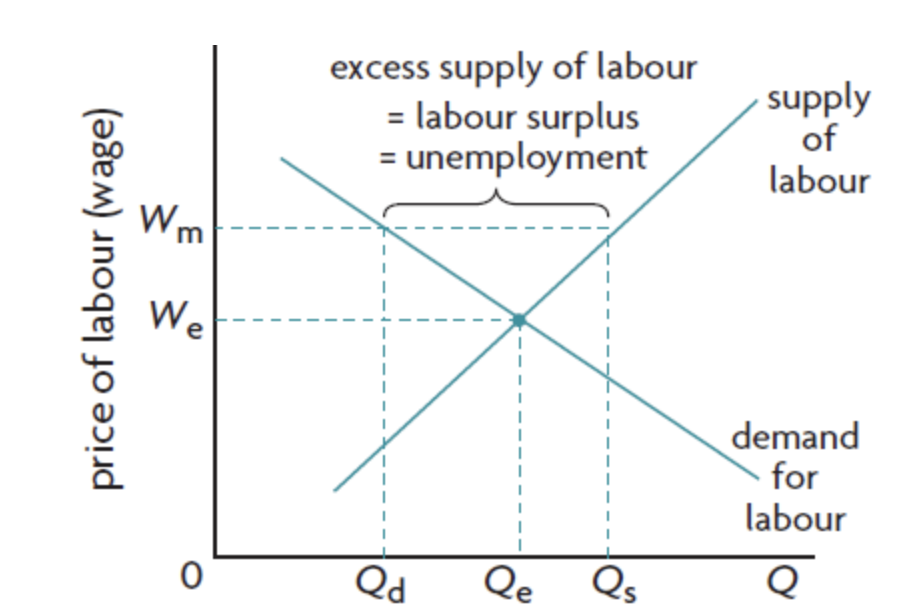
how to calculate amount of workers that loose their job due to minimum wages
workers who lost their job - Qe-Qd
new workers (newley willing + able to work) - Qs-Qe
total - Qs-Qd
consequence of minimum wage on labour productivity in real world
some times minimum wage causes an increase in labour productivity as workers feel motivated to work harder
setting fixed prices
prices cannot increase or decrease
usually used for concert/sports events tickets (supply is fixed)
can result in shortage/surplus
maximum prices definition
prices set by the government below equilibrium price in order to protect consumers (especially low income)
often used for rent control + price of food items
maximum price on a supply + demand diagram - simple
max price line below equilibrium price
supply contracts
demand expands
→ shortage
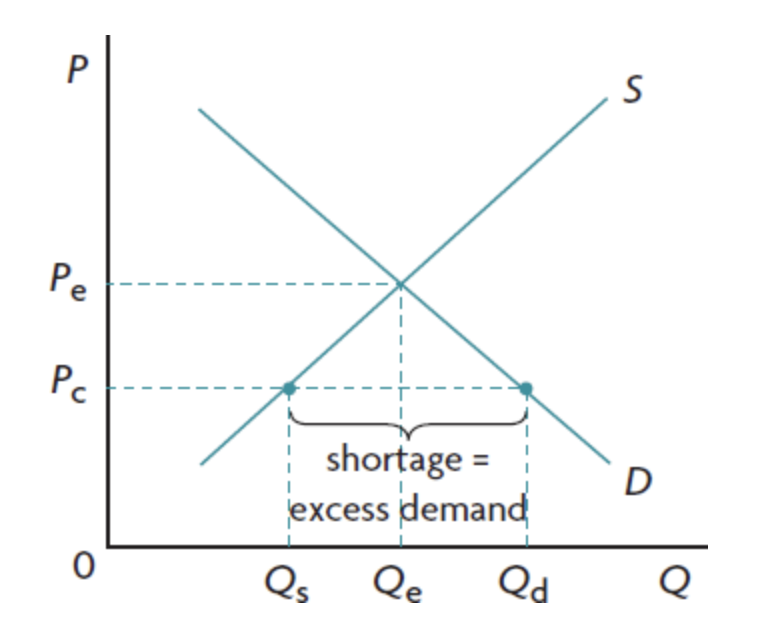
consequences of maximum prices on markets
shortages - not everyone who is willing + able to buy can buy do to shortage → not enough supply
non price rationing
underground/parallel markets
underallocation of resources to the g/s + allocative inefficiency
negative welfare impacts
non-price rationing - consequences of maximum prices on markets
(not enough of the good/service is produced and so has to be allocated to consumers using non-price rationing techniques such as : )
assumes that all producers sell at max price
first-come first-served
favouritism : sellers sell goods to preferred customers
needs-based allocation
everyone is allocated a certain amount
underground/parallel markets - consequences of maximum prices on markets
involve buying a good at the maximum/legal price and then re-selling it at a price above the legal maximum
underground markets occur when there are dissatisfied people who were not able to buy the g/s as there was not enough of it + are willing to pay more than the price ceiling to get it.
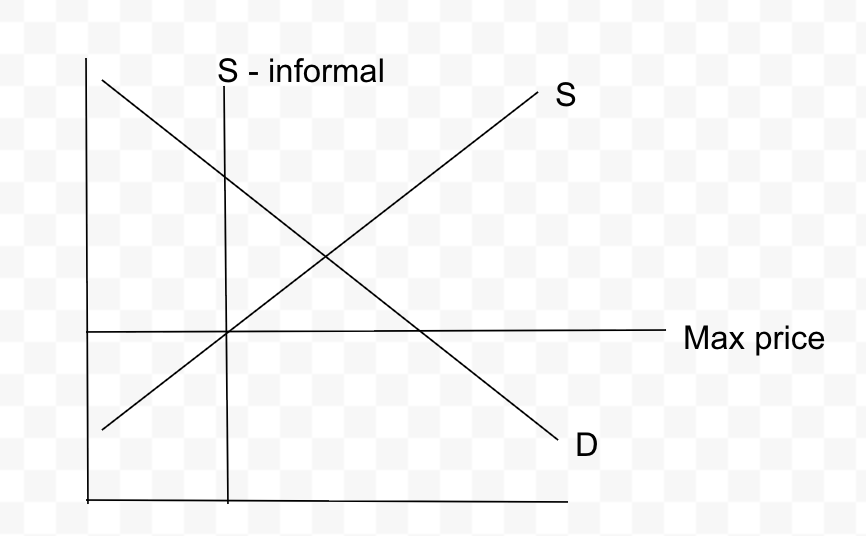
underallocation of resources + allocative inefficiency - consequences of maximum prices on markets
not enough resources are allocated into the production of the g/s → underproduction relative to social optimum
society is worse off
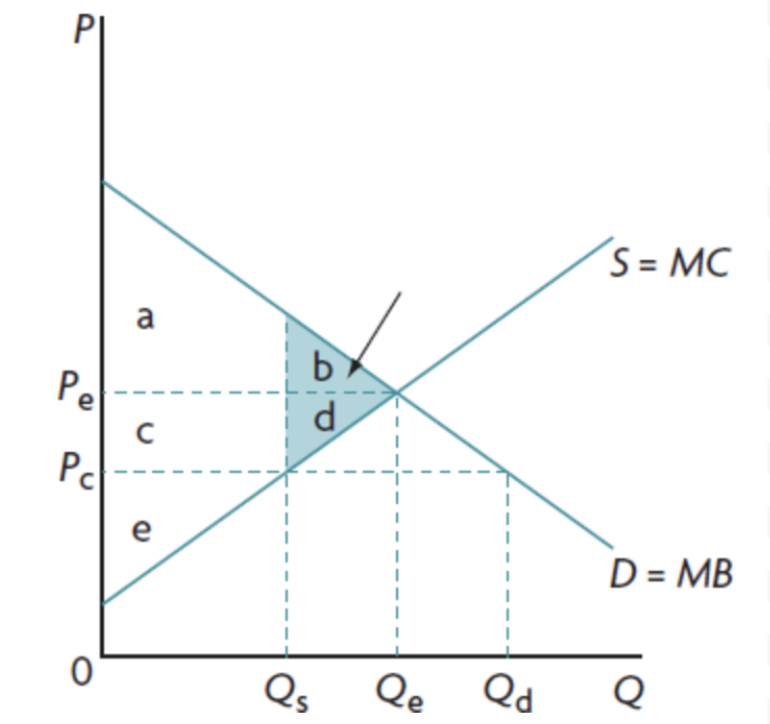
label for normal maximum price and when there is an informal market- consequences of maximum prices on markets
normal -
CS : a + c
PS : e
DWL : b + dinformal
CS : a
PS : c + e
DWL : b + d

welfare loss definition
social surplus or welfare benefits that are lost to society due to allocative inefficiency
how can we see on a demand and supply diagram that maximum prices lead to allocative inefficiency
MB>MC at point of production
the benefit consumers receive from the last unit of the good they buy is greater than the marginal costs of producing it
consequences of maximum prices on stakeholders - consumers
consumers who are now able to buy the good at the lower price are better off
some consumers still remain unsatisfied as even though they were willing + able to buy not enough of the good was produced and so they dont get to buy at all.
consequences of maximum prices on stakeholders - producers
worse off
sell a smaller quantity + at a lower price → revenues fall from equilibrium qt x p to max price x qt demanded at max price
can be seen in loss in producer surplus to consumers + DWL
consequences of maximum prices on stakeholders - workers + government
workers - worse off → qt supplied decreases → workers get fired → unemployment
government - no gain/loss in government budget, however the government can gain in popularity among consumers that are better of due to price ceiling
rent controls - example of max prices
maximum legal rent on housing
housing is more affordable for low income earners
of housing - qt demanded at max price is larger than qt of houses
long waiting lists of tenants
underground market formed where landlords charge above max rent
poorly maintained housing due to land owners not being incentivised to maintain/renovate as it is unprofitable
food price controls - example of max prices
food is more affordable for low-income earners
food shortages
non-price rationing methods take place
underground market creation
failing farmers due to low revenues
more unemployment in agricultural sector
misallocation of resources
greater popularity of government amongst consumers who benefit